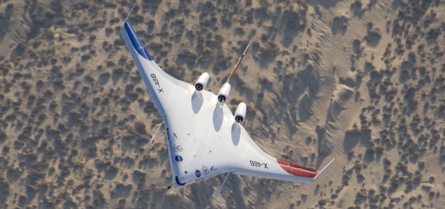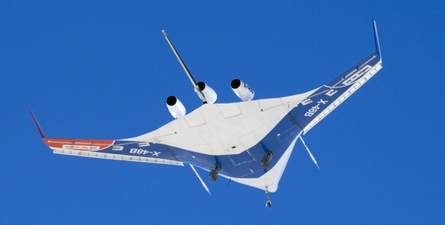Citing interest in the potential environmental benefits of blended wing-body aircraft, NASA is looking at using Boeing's X-48B subscale demonstrator for noise tests.
If funded, the research would investigate the noise shielding provided by having engines mounted above a flying wing.
Interest in the blended wing-body, or BWB, configuration has increased since the Cambridge-MIT Institute's Silent Aircraft Initiative released research showing the noise of a flying-wing aircraft could be limited to within the boundaries of an airport.

© NASA
Two X-48Bs were built by the UK's Cranfield Aerospace to evaluate the low-speed flying characteristics of the BWB. The unmanned aircraft first flew at NASA's Dryden Flight Research Center on 20 July and is now on the ground for modification and upgrades following six flights.
Modifying the X-48B for noise tests is one of many ideas submitted in response to a NASA call for proposals for research into meeting its targets for an "N+2 generation" transport aircraft, which include reducing noise to a cumulative 52EPNdB below Stage 3 by around 2020, says Dennis Huff, subsonic fixed-wing programme manager.
Award of contracts under the NASA Research Announcement is expected to take place within a few weeks.
If a project involving the X-48B is funded, it will likely involve a paper study, followed by ground testing and some flight tests of a modified aircraft, says Huff. As the flying wing provides ample shielding of the forward fan noise, the work is expected to focus on aft fan and jet noise.
"As we go to higher bypass ratios jet noise moves closer to the nozzle, which should make shielding more effectice," he says. "But we need to do a parametic study of that for a hybrid wing-body to see if there is an optimum design."

© NASA
After completing its initial flights with leading-edge slats fixed in the extended, high-lift position, X-48B Ship 2 is now being fitted with fixed retracted slats. Flight control software and actuators are being upgraded and the aircraft is expected to fly again in mid-October.
The planned total of 20-25 flights is expected to be completed by March or April next year, after which the two X-48Bs will be available as test assets for further research. "The assets are on the table, but there is no decision yet," says Huff.
NASA is also looking at the possibility of modifying the 8.5%-scale aircraft to test the BWB's transonic flying characteristics. As the X-48B with its fixed gear and model-aircraft jet engines was only designed to fly up to 120kt and 10,000ft, that would require substantial modifications.
"Boeing and Cranfield feel it could go transonic, but we have not done the analysis," says NASA.

© NASA
Source: FlightGlobal.com



















